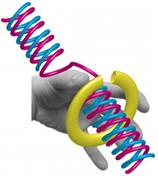Scientists Unveiled the Mysterious Procedure in Human DNA Replication

As an illustration, the picture represents a crucial molecular player in the process, by a hand, which is loading the sliding clamp ring onto DNA.
According to the report of eLife on April 2, 2013, the long mysterious mechanism in human DNA replication has been identified for the first time.
For a long time, the key procedure in DNA replication is being unclear. Either in humans or in other organisms, sliding clamps, the load of molecular structure onto DNA is necessary for part of DNA replication process. Due to the under-standard knowing, the human DNA replication is not well studied.
As the above picture shows, the sliding clamp is a ring-shaped protein that acts to encircle the DNA strand, latching around. The sliding clamp then serves to anchor special enzymes—polymerases to the DNA, which ensure efficient copying of the genetic material. Without a sliding clamp, polymerases can copy very few bases every time. But the clamp helps the polymerase to stay in place, allowing it to copy thousands of bases before being removed from the strand of DNA. Due to the closed circular structure of sliding clamps, another necessary step in DNA replication is the presence of a "clamp loader," which acts to latch and unlatch the sliding clamps at key stages during the process. As to finding the answer, the question falls on how the sliding clamp and the clamp loader interact and the timing of latching and unlatching of the clamp from the DNA.
Because polymerases and clamp loaders can't bind the sliding clamp at the same time, researchers assumed that clamp loaders latched sliding clamps onto DNA, and then left for some time during DNA replication, returning only to unlatch the clamps after the polymerase left so they could be recycled for further use.
To test the assumption, researchers used a method called Förster resonance energy transfer (FRET), a technique of attaching fluorescent "tags" to human proteins and sections of DNA in order to monitor the interactions between them. With these tags in place, scientists then observed the formation of holoenzymes, which consists of the polymerase itself along with any accessory factors that optimize its activity. Then they found that whenever a sliding clamp is loaded onto a DNA template in the absence of polymerase, the clamp loader quickly removed the clamp so that free clamps did not build up on the DNA. However, whenever a polymerase was present, it captured the sliding clamp and the clamp loader then dissociated from the DNA strand. The team members also found that, during the moments when both the clamp loader and the clamp were bound to the DNA, they were not intimately engaged with each other. Rather, the clamp loader released the closed clamp onto the DNA, allowing an opportunity for the polymerase to capture the clamp, completing the assembly of the holoenzyme. Subsequently, the clamp loader dissociated from DNA.
The research demonstrated that the DNA polymerase holoenzyme in humans consists of only a clamp and a DNA polymerase. The clamp loader is not part of it. It disengages from the DNA after the polymerase binds the clamp.
Article Link: Scientists Unveiled the Mysterious Procedure in Human DNA Replication
Tags: Human DNA Replication, Clamp, DNA Polymerase


